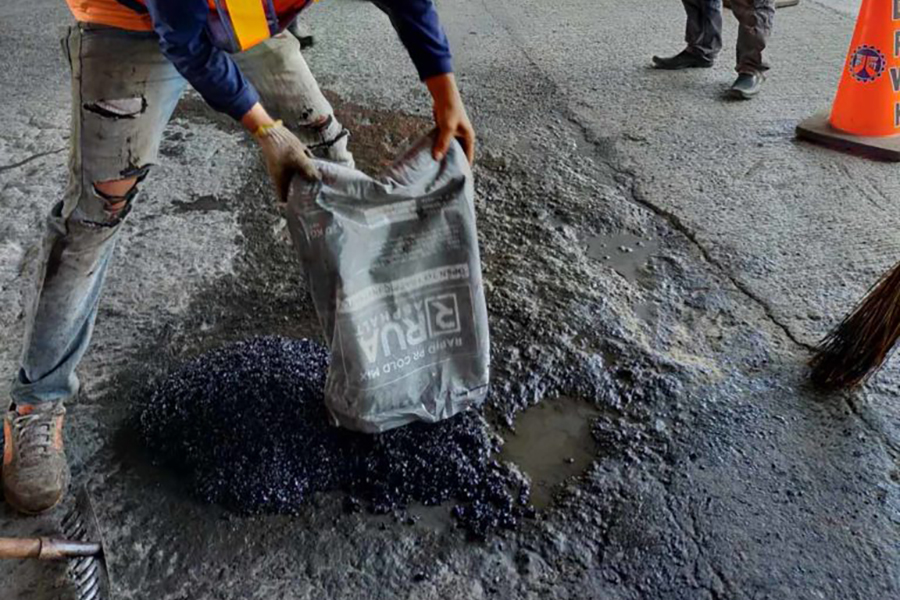Hot Mix Asphalt Paving: Elevating Commercial Parking Lot Requirements
Hot Mix Asphalt Paving: Elevating Commercial Parking Lot Requirements
Blog Article
Unlocking the Secrets of Hot Mix Asphalt Technology
Discovering the depths of hot mix asphalt technology uncovers a world where meticulous processes and accurate formulas assemble to shape our roads and facilities. The combination of fillers, accumulations, and binders isn't just a building and construction task yet a critical orchestration of toughness and performance.
Value of Warm Mix Asphalt
Hot Mix Asphalt plays an important duty in contemporary framework development as a result of its resilience and cost-effectiveness. As one of the most commonly utilized leading material for roadways, freeways, and vehicle parking whole lots, Hot Mix Asphalt uses an array of benefits that add to its importance in building tasks. One key advantage is its capacity to withstand rush hour loads and extreme climate condition, giving a trusted and long-lasting surface for transport networks. Additionally, Hot Mix Asphalt is economical in both first building and construction and long-term maintenance, making it a preferred option for lots of framework tasks.
The toughness of Hot Mix Asphalt stems from its composition, which includes accumulations, binder, and filler products that are carefully picked and blended to meet details efficiency requirements. Overall, the value of Hot Mix Asphalt in infrastructure development can not be underrated, as it continues to be a cornerstone of modern-day building and construction techniques.
Parts of Asphalt Mixes
The composition of asphalt blends consists of carefully selected accumulations, binder, and filler materials that are crucial for achieving details performance needs. Aggregates are the primary part of asphalt blends, providing toughness and security. These aggregates can be natural, such as gravel or smashed stone, or artificial, like recycled products from old pavements. The binder, usually bitumen or asphalt cement, holds the aggregates together and gives versatility and toughness to the mix. The choice of the binder is important as it straight influences the mix's efficiency in different weather condition problems. Fillers, such as hydrated lime or Portland cement, are utilized to enhance the mix's workability and aging resistance. Angled Parking.
The combination and proportion of these components play a significant role in identifying the high quality and performance of the asphalt mix. Engineers thoroughly develop the mix to satisfy certain needs, taking into consideration factors like traffic volume, environment problems, and sidewalk life-span. Appropriate choice and balancing of aggregates, binder, and fillers are vital for producing sturdy, durable asphalt pavements.
Mixing and Production Methods

When the accumulations are picked, the binder, often asphalt cement, is contributed to bind the materials together. The binder's high quality and amount dramatically influence the mix's strength, flexibility, and resistance to environmental elements. Furthermore, fillers like moisturized lime or Rose city cement check it out may be integrated to enhance particular attributes of the asphalt mix, such as its workability or dampness resistance.
Throughout production, the accumulations and binder are warmed, usually between 250-325 ° F(121-163 ° C ), to promote mixing and guarantee correct layer of the aggregates. The mixing process has to be detailed to achieve a homogeneous blend that promotes the desired performance attributes of the asphalt. Numerous techniques, such as batch mixing or drum mixing, are employed to accomplish regular and top quality asphalt mixes for building and construction tasks.
Aspects Influencing Asphalt Efficiency
Variables influencing asphalt efficiency include a variety of variables that impact the sturdiness, longevity, and general top quality of asphalt pavements. One essential factor is the high quality her comment is here of products utilized in the asphalt mix.
Environmental problems also influence asphalt performance. Temperature level variants, wetness seepage, and traffic tons can all impact the structural integrity of the pavement. Layout factors to consider, such as pavement thickness and drainage, are necessary in guaranteeing the long-lasting performance of the asphalt sidewalk. By very carefully considering these professionals, designers and variables can optimize asphalt efficiency and improve the service life of sidewalks.
Sustainable Practices in Asphalt Technology

WMA permits for the production and positioning of asphalt mixes at lower temperature levels compared to standard hot-mix asphalt, resulting in lowered energy intake and greenhouse gas emissions. The usage of permeable asphalt mixes can assist minimize stormwater overflow concerns by enabling water to penetrate via the pavement and into the ground, advertising all-natural water filtration and charge procedures.
Conclusion
To conclude, warm mix asphalt modern technology plays an essential function in contemporary facilities advancement because of its longevity and cost-effectiveness. By carefully balancing components, employing proper mixing techniques, and considering various elements, engineers can create high-quality asphalt mixes that withstand rush hour lots and rough climate condition. Accepting sustainable practices, such as using recycled materials and warm-mix modern technologies, better improves the environmental friendliness of asphalt modern technology.
Blending and manufacturing methods in hot mix asphalt modern technology entail the exact combination and processing of accumulations, binder, and fillers to produce a durable and high-performance asphalt mix.Aspects influencing asphalt efficiency include a range of variables that influence the toughness, durability, and total top quality of asphalt pavements. Lasting methods in asphalt technology include various campaigns aimed at lowering the environmental influence of asphalt production and paving procedures. By integrating redeemed asphalt pavement (RAP) and recycled asphalt tiles (RAS) into brand-new asphalt mixes, the sector can substantially reduce the usage of raw materials and power, while also lowering landfill waste.
WMA permits for the production and positioning of asphalt mixes at lower temperature levels compared to typical hot-mix asphalt, resulting in decreased power consumption and greenhouse gas discharges.
Report this page